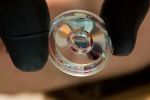The 79-year-old astronaut says: Enough about the moon; let's go to Mars
By Douglas Wright
Posted 21.07.2020 at 1:55 am
Preparing for an Apollo 11 Countdown Test: NASA
It's been 40 years since Neil Armstrong and Edwin "Buzz" Aldrin landed the Apollo 11 lunar module in the Sea of Tranquility. Aldrin, now 79 years old, recalls that fateful day with clarity. Alarms were sounding inside the space capsule during their speedy descent, and even down to the last seconds, the astronauts were uncertain whether they would need to abort the landing. Millions of Earthlings watched on television as the Eagle touched down.
Much has changed over four decades, and despite the success of the International Space Station, enhanced shuttle technology, robotic rovers, and satellites which bring us back daily analytical data from our solar system, the visionary optimism that once propelled the space race and captured the world's collective imagination has waned. Ironically, with the loss of this optimism, the very notion of manned space travel beyond our moon seems to have become antiquated itself.
[
Read Full Story ]








